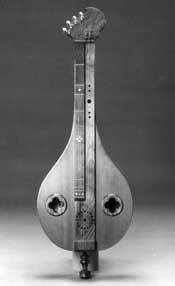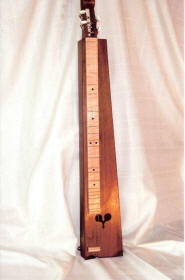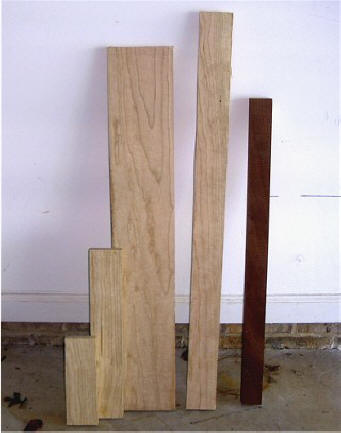
In fact, the three zither-related instruments most closely related to the mountain dulcimer are of Scandinavian, German and French origin. Probably the oldest progenitor of the mountain dulcimer would be an instrument called a Hummel, which dates back to the Middle Ages. This instrument (pictured right) was relatively easy to make, and was very popular among Swedish peasants. Like most of the dulcimer progenitors, it had paired melody strings and unfretted drone strings, which actually gave the instrument its name ('Hummel' means 'bee') since the droning sound reminded people of the humming of bees.

Another ancestor of the mountain dulcimer is probably the scheitholt, a German instrument that can be accurately dated to the fifteenth century. Like the Hummel, the scheitholt had fretted and droning strings, and is considered to have descended directly from the Hummel. As you can see in the picture to the left, there isn't an actual fretboard, but rather wires that are set into the soundboard of the instrument, which allowed the player to change pitch on the strummed strings, while other strings droned.

Most mountain dulcimers are played in a diatonic scale, a 7-note scale using five whole steps and two half-steps (compared to the chromatic scale used in pianos and guitars, which use a 12-note scale using seven whole steps and five half steps, the half-steps being sharps and flats).
Because only two strings are fretted, and there are only seven notes to each scale, the mountain dulcimer is a very easy instrument to play. It's also one of the easiest tunable-string instruments to build. That makes it a great project for a first-time luthier.
In general, being a folk instrument, it's traditional to make the mountain dulcimer with locally obtainable woods. For that reason, most dulcimers made in the mountains of Appalachia tend to be constructed from woods like cherry, walnut, ash, and even tulip poplar. In some areas, sugar and silver maple have been employed. Soundboards can be made of softer woods like spruce and cedar--as in guitars--though many constructors use the same wood for the soundboard as they do for the back and sides.
The lighter-colored wood pictured here will be used for the back and sides of our dulcimer. It's cherry (genus Prunus), a relatively common wood in many parts of the world. There are literally dozens of species of Prunus, and to be perfectly frank I'm not certain which one this is. Most likely, it is either black cherry (Prunus serotina), or Western Laurel Cherry (Prunus occidentalis)
What cherry brings to the table is that it produces a bright, ringing tone, which is perfect for musical instruments. In addition, it polishes to a bright, smooth sheen, and it glues and takes finishes nicely.
The darker piece of wood pictured to the right of the cherry boards is Sapele (Entandrophragma cylindricum). This is a cutoff piece from an earlier project. Like cherry, Sapele is still relatively plentiful, but even so I never discard even the smallest piece of it. I can usually find some use for every little flitch sooner or later. Never waste, never worry. If you follow a lot of the woodworking projects on this website, you'll likely note that I use sapele a lot. It's a wonderful substitute for endangered mahogany, works easily, doesn't produce a lot of problems with wood allergies, and finishes beautifully. In this case, I will be using some of this piece for our fretboard, a purpose for which it is perfectly suited. I will also likely use a thin piece of purpleheart (Peltogyne purpurea, not pictured here) to top off the fretboard, since it is very colorful and extremely dense. Harder woods make for excellent fretboards, since they take a lot of punishment during playing.
I haven't decided yet which wood to use for the soundboard. I could use Sitka spruce (Picea sitchensis) or to go with Western red cedar (thuja plicata). Many of the original builders in the Appalachian Mountains may have had access to Western cedar, and therefore it may be a more traditional wood. In addition, the mellow sound qualities of cedar might balance out the bright ringing tone of the cherry. I'll make a decision on which way to go as we move along.
The rosettes pictured may or may not be used on our instrument. I haven't decided whether it will have a Celtic theme, or if I will go with viola-style 'f' holes.

The similarities to the Hummel and the scheitholt are unmistakable. It appears to date from the 18th century, which also suggests that it was influenced by earlier Scandinavian and German instruments. Like the Hummel and scheitholt, the epinette des Vosges has wire frets set into the soundboard of the instrument, and includes both fretted and droning strings.
All right! So we have most of our major components together. Now we start the fun part - putting it all together to make a musical instrument!
We will begin by building the anchor for our instrument--the peghead.
You can watch this process on the next page.
This particular set of plans is based on a 1981 Antes hourglass-shaped dulcimer. Prior to 1981, most dulcimers used a peghead with slots sawn for the sides to slide into, where they were captured and glued. Beginning around 1981 builders began to
